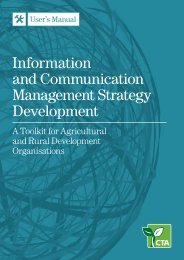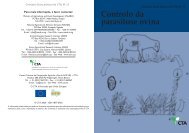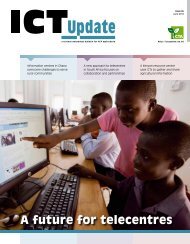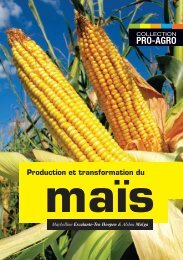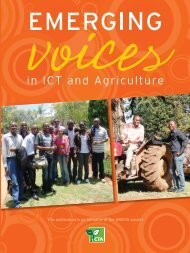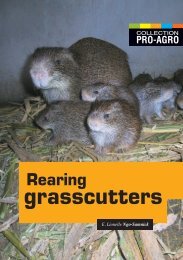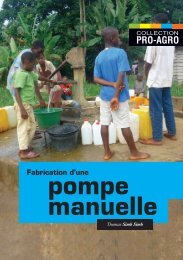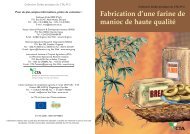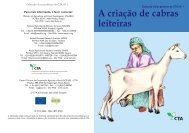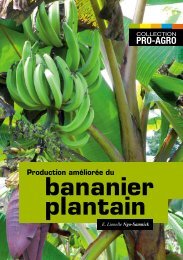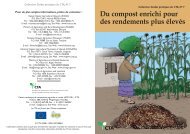Policy framework for Pastoralism in Africa
Policy framework for Pastoralism in Africa
Policy framework for Pastoralism in Africa
- No tags were found...
You also want an ePaper? Increase the reach of your titles
YUMPU automatically turns print PDFs into web optimized ePapers that Google loves.
social welfare. To take advantage of these positive aspects of pastoralism, appropriate governanceand an enabl<strong>in</strong>g pastoral policy environment is needed.A specific, priority policy area is the need to clarify property rights <strong>in</strong> pastoral regions. This isdetailed under strategy 2.1 below, and is crucial not only <strong>for</strong> pastoral women and men, but also<strong>for</strong> <strong>for</strong>eign or local commercial <strong>in</strong>vestors, some of whom seek to engage <strong>in</strong> ranch<strong>in</strong>g or the developmentof oil and m<strong>in</strong>eral deposits. The ability to secure access to pastoral land resources througha variety of tenure systems that guarantee returns <strong>for</strong> short- or long-term <strong>in</strong>vestments is important<strong>for</strong> the improvement of livestock productivity <strong>in</strong> general, and food security <strong>in</strong> particular. Clearproperty rights <strong>in</strong> livestock farm<strong>in</strong>g also have the potential of <strong>in</strong>creas<strong>in</strong>g revenues through taxationand enhancement of export of livestock products.Strategy 1.7 Service deliveryWith<strong>in</strong> a given country, pastoralists experience the worse levels of basic service provision. Thisproblem relates to the political marg<strong>in</strong>alization of pastoralists, and the relatively high transactioncosts of service provision <strong>in</strong> remote, large areas with small and mobile populations. In general theeducation and health <strong>in</strong>dicators <strong>for</strong> pastoral areas of <strong>Africa</strong> are among the lowest anywhere <strong>in</strong> theworld. Given the pressures on pastoral economies, education must be viewed as a key long-termstrategy <strong>for</strong> economic diversification.With<strong>in</strong> the broad challenge of service delivery <strong>in</strong> pastoral areas are a set of specific barriers affect<strong>in</strong>gaccess to health and education <strong>for</strong> women and girls. While <strong>in</strong>dicators <strong>for</strong> pastoral populationsare low, the use of health and education facilities by women and girls is especially low due to variousproblems with the design of service delivery, coupled with socio-cultural factors and genderdiscrim<strong>in</strong>ation. In addition, given the spread of HIV/AIDS, pastoralists are at particularly risk dueto the very weak health care and communication systems <strong>in</strong> their areas.Despite the problems of service provision <strong>in</strong> pastoral areas, there have been notable successes <strong>in</strong>terms of alternative service delivery models. In education these <strong>in</strong>clude distance learn<strong>in</strong>g and alternativebasic education approaches; <strong>in</strong> health, community case management and community healthworker systems have been proven to be effective; <strong>for</strong> basic veter<strong>in</strong>ary care, community-based animalhealth workers can be used. In some countries, these and other approaches – tailored specificallyto the pastoral context - require policy support if they are to be scaled-up and properly regulatedand monitored.Objective 2Re<strong>in</strong><strong>for</strong>ce the contribution of pastoral livestock to national, regional and cont<strong>in</strong>ent-wideeconomies.Objective 2 of the <strong>framework</strong> is based on the need to improve pastoral resource governance <strong>for</strong>efficient conflict prevention and secured pastoral resource property rights, both with<strong>in</strong> and acrossborders, and, support pastoral, mobile livestock production, and the process<strong>in</strong>g and market<strong>in</strong>g oflivestock products. There<strong>for</strong>e, the strategies under Objective 2 can be summarized as follows:--Strengthen pastoralist access to their rangelands, through appropriate re<strong>for</strong>m of land tenurepolicy and legislation, and supported by participatory land use plann<strong>in</strong>g;--Support the further development of regional and national policies to enable pastoral mobility36 <strong>Policy</strong> <strong>framework</strong> <strong>for</strong> <strong>Pastoralism</strong> <strong>in</strong> <strong>Africa</strong>




